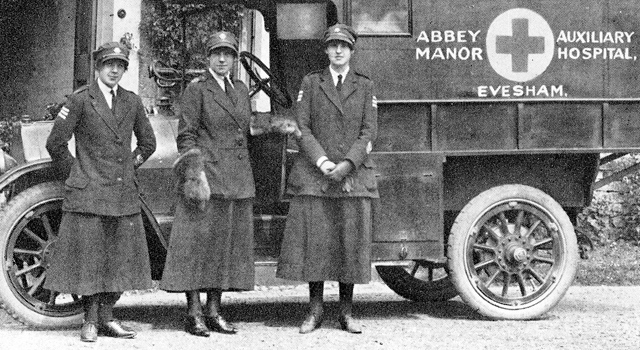Articles

No Comments
By Voices
On 30, Jun 2014 | No Comments | In Gender | By Voices
Caring for the Wounded in Local Communities
Professor Maggie Andrews, University of Worcester
The first industrial war, caused both minor and major damage to the minds and bodies of the soldiers who took part. Illness and disease such as typhoid and trench foot took soldiers also out of the front line. More than half of these soldiers who needed medical care were sent to the United Kingdom where over 3,000 convalesce or auxiliary hospitals were set up in private homes.
One of the first of these was at Evesham Manor Hospital which the owner Mrs Rudge had ready to receive patients by September 24 1914. The hospitals generally worked with the Red Cross for whom support was ubiquitous in wartime. The organisation raised 22 million pounds between 1914 and 1918; its mission touched the spirit of the era consequently its annual flag day was called ‘Our day’.
These hospitals did not merely rely on the charitable activities of the wealthy, communities, clubs and workplaces close by all shared the responsibility of caring for the wounded men who stayed for a few weeks or several months. Local farmers donated food to the convalesce hospitals and across the country people became involved in the National Egg Collection for the Wounded Soldiers; a scheme set up in 1915 with Queen Alexandra as the patron. Over 2000 collection points were organised by volunteers from where eggs were packed into boxes with straw, and shipped to hospitals in France and Britain. Furthermore women who lived in the vicinity of hospitals provided a place to stay for wives and mothers visiting their husbands and sons who were ill or wounded.
The servicemen who were patients, dressed in what became characteristic blue and yellow injured soldier’s uniform, were recognisable to local communities; for as their health improved they were able to go out of the hospital and taken on sightseeing trips sometimes by munitions workers. Local residents put on concerts and plays and in Evesham the Town Council placed a number of seats in the town-centre for the use of wounded soldiers only. Evesham also introduced a canteen for all men in uniform and their friends; which proved popular with the inmates from the hospital and soldiers home on leave. Many of the social events and activities that took place around the hospitals were geared towards raising funds that were vital for hospitals’ functioning. Whist drives and garden fetes were particularly popular but sporting events – for example between the wounded and local women’s football or cricket teams – were in Worcestershire also frequently reported in local newspapers.
![Evesham Manor Hospital’s motorised ambulance acquired in 1918 [Courtesy of the Rudge family]](http://www.voicesofwarandpeace.org/wp-content/uploads/2014/06/evesham-manor-hospital-ambulance-w.jpg) Many of the arrangements were somewhat ad hoc, Mrs Rudge and her daughter at Evesham Evesham Manor Hospital used their own cars to ferry soldiers to and fro from the train station, but as the war progressed and the casualties increased their cars struggled to cope. In the Spring of 1918 plans for a great offensive on the Western Front meant that in preparation hospitals were urged to increase the number of beds they had available. A new ambulance stood at the ready at Evesham Manor Hospital purchased through the fundraising activities of town and their Annual Garden Fete.
Many of the arrangements were somewhat ad hoc, Mrs Rudge and her daughter at Evesham Evesham Manor Hospital used their own cars to ferry soldiers to and fro from the train station, but as the war progressed and the casualties increased their cars struggled to cope. In the Spring of 1918 plans for a great offensive on the Western Front meant that in preparation hospitals were urged to increase the number of beds they had available. A new ambulance stood at the ready at Evesham Manor Hospital purchased through the fundraising activities of town and their Annual Garden Fete.



Submit a Comment